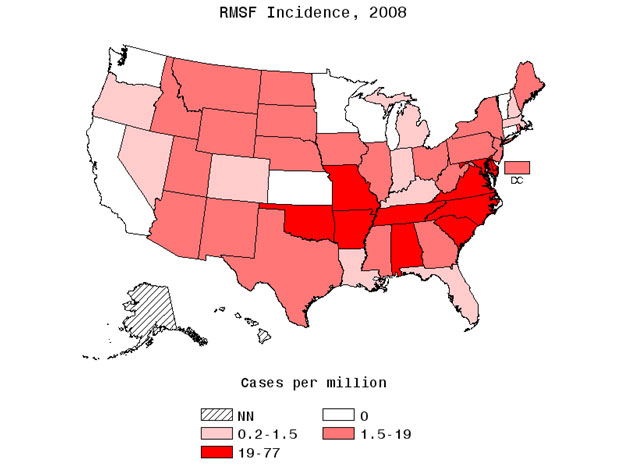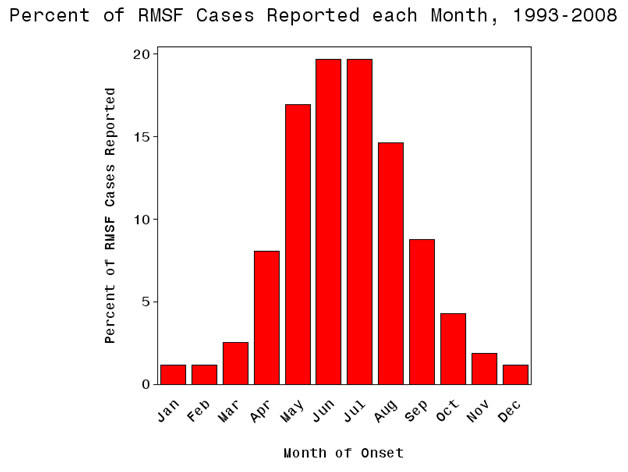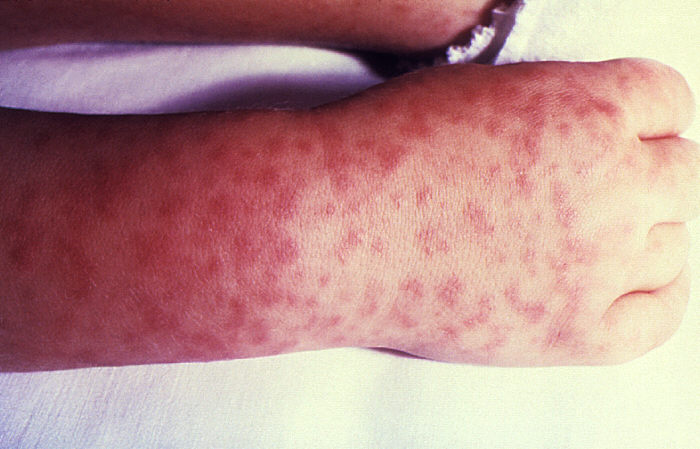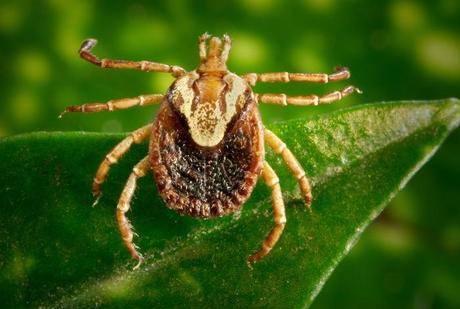Rocky Mountain Spotted Fever: Difference between revisions
No edit summary |
No edit summary |
||
| Line 115: | Line 115: | ||
== Medications == | == Medications == | ||
Doxycycline is the standard medication prescribed when physicians are suspicious of RMSF.<ref name="CDC1" /> Adults are prescribed to take 200mg by mouth or IV two times per day.<ref name="Johnson" /> Children who weigh less than 100lbs are to take 2mg/lb by mouth and those children who weigh above 100lbs are suggested to take the same dosage as an adult, 200mg by mouth or IV, two times per day. <ref name="Johnson" />. Medical treatment should be continued for a minimum of 3 days after one's fever had decreased. Typically, medical treatment of this disease will last anywhere from 7-14 days in length.<ref name="CDC1" /><br> | Doxycycline is the standard medication prescribed when physicians are suspicious of RMSF.<ref name="CDC1" /> Adults are prescribed to take 200mg by mouth or IV two times per day.<ref name="Johnson" /> Children who weigh less than 100lbs are to take 2mg/lb by mouth and those children who weigh above 100lbs are suggested to take the same dosage as an adult, 200mg by mouth or IV, two times per day. <ref name="Johnson" />. There has been some previous cause for concern that older medications such as tetracyclines may cause staining of a child's permanent adult teeth, however, recent treatment with doxycycline has not been shown to cause staining.<ref name="CDC1" /><ref name="Minniear">Minniear T, Buckingham S. Managing Rocky Mountain spotted fever. Expert Reviews. Anti Infect. Ther.7(9),1131-1137(2009)</ref> Medical treatment should be continued for a minimum of 3 days after one's fever had decreased. Typically, medical treatment of this disease will last anywhere from 7-14 days in length.<ref name="CDC1" /><br> | ||
If an allergy to doxycycline exists or a if a women is pregnant, other medications are available as treatment <ref name="CDC1" />. Chlorampenicol is another antibiotic that may be prescribed, however, this medication has some adversve side effects such as: aplastic anemeia and grey baby syndrome<ref name="CDC1" />. Recommended dosing for Chloramphenicol is General spectrum antibiotics have not been found to be effective against RMSF and sulfa drugs may actually worsen the infection<ref name="CDC1" />. | If an allergy to doxycycline exists or a if a women is pregnant, other medications are available as treatment <ref name="CDC1" />. Chlorampenicol is another antibiotic that may be prescribed, however, this medication has some adversve side effects such as: aplastic anemeia and grey baby syndrome<ref name="CDC1" />. Recommended dosing for Chloramphenicol is General spectrum antibiotics have not been found to be effective against RMSF and sulfa drugs may actually worsen the infection<ref name="CDC1" />. | ||
Tetracyclines have been found to increase hypthrombiemic effects of anticoagulants, and they have also been found to decrease the effectiveness of common oral contratceptives. <ref name="Johnson" /> | Tetracyclines have been found to increase hypthrombiemic effects of anticoagulants, and they have also been found to decrease the effectiveness of common oral contratceptives. <ref name="Johnson" /> | ||
Revision as of 03:45, 6 April 2011
Original Editors - David Grinnell from Bellarmine University's Pathophysiology of Complex Patient Problems project.
Lead Editors - Your name will be added here if you are a lead editor on this page. Read more.
Definition/Description[edit | edit source]
Rocky Mountain Spotted Fever (RMSF) is a tick born disease, due to an intracellular pathogen known as Rickettsia rickettsi.[1] This pathogen is carried by ticks and is transmitted to humans via a bite from an infected tick; thus it is considered and infectious disease as well as a zoonotic disease. Three known ticks in the United States carry this pathogen: the American dog tick (Dermacentor variabilis), Rocky Mountain wood tick (Dermacentor andersoni) and the brown dog tick (Rhipicephalus sanguineous). The American dog tick carries the pathogen in the western United States, and the wood tick carries the pathogen in the eastern United States [2]. This infection was first described in the Rocky Mountains in Idaho in 1896. Howard Ricketts found the causative agent in the early 1900’s. [1]. This systemic infectious disease is treatable, however, if left untreated it can be fatal.
Prevalence[edit | edit source]
United States
Between 1993 and 1996, there were 1253 reported cases of Rocky Mountain Spotted Fever (RMSF). This amount of confirmed incidence is roughly 2.2 cases per million. [1] Since that time period there has been some increase in confirmed cases. In 2008, the number of cases jumped to approximately 8 per million. However, the number of fatalities has decreased and currently is about 0.5%.
There is some distinction between race in the diagnosis of RMSF. Causcasians are two times more likey to be diagnosised that those of African American decent. Compared to the general population, American Indians are at the greatest risk for contracting the disease. For data that was collected between the years of 2001 and 2005, the American Indian incidence rate was calculated at 16.8 per million, while caucasians were at 4.2 per million, African Americans at 2.6 per million, and Asian/Pacific Islanders at 0.5 cases per million people.[3]
RMSF is more common in males than females; the calcuated ratio is 1.7:1[3]
RMSF has varying incidence rates when age is taken into account. The aging population, specially the 60-69 year old and childrent between the ages of 5-9 have the highest incidence rate. [3]
- 60-69 year old age group - 3.1 cases per million [3]
- 5-9 year-old age group - 3.3 cases per million [3]
Even though the disease is known as Rocky Mountain spotted fever, it is more commonly found in the eastern United States. Georgia, Maryland, North Carolina, Oklahoma, South Carolina, Tennessee, and Virginia are among the states that have confirmed the largest number of cases. [3]
photo courtsey of:http://www.cdc.gov/rmsf/stats/
graph courtsey of:http://www.cdc.gov/rmsf/stats/
Worldwide
Other cases of RMSF have been confirmed in Canada, Mexico, Central America, Columbia, as well as Brazil. Currently, there haven’t been any confirmed cases of RMSF beyond the boarders of the American continents.[3]
Characteristics/Clinical Presentation[edit | edit source]
The R. ricketttsii pathogen can have numerous systemic manifestations affecting the: cardiac, pulmonary, gastrointestinal, renal, neurological, ocular, musclecoskeletal, and integumentary systems.[2] If infected the individual may face moderate to severe illness. The initial symptoms usually will begin 2-14 days after being bitten by an infected tick.[6]
Initial symptoms include [1][2][3][7]
- high fever - reaching temperatures to 102 degrees Fahrenheit (38.9 degrees Celsius) or greater
- chills
- severe headache
- nausea
- vomitting
- fatigue
- loss of appetite
- abdominal pain - may present as appendicitis
- conjunctival infection
- muscle pain
Additional signs and symptoms that may develop include the following:
- a red-spotted rash that spreads to a majority of the body -this rash occurs in approximately 90% of those infected with RMSF and usually appears 2-5 days after the fever has been present
- restlessness
- diarrhea
- aches & pains
- delirium
After completing a thorough examination, a patient's laboratory workup may show the following results: [2]
- usually normal periphearl WBC count
- thrombocytopenia
- elevated aminotransferase levels
- hyponatremia
- anemia
- elevated bilirubin level
- elevated level of creatine kinase
- elevated CSF and WBC count with monocyte predominance
- serological tests negative until convalescence
Associated Co-morbidities[edit | edit source]
add text here
Medications[edit | edit source]
Doxycycline is the standard medication prescribed when physicians are suspicious of RMSF.[7] Adults are prescribed to take 200mg by mouth or IV two times per day.[3] Children who weigh less than 100lbs are to take 2mg/lb by mouth and those children who weigh above 100lbs are suggested to take the same dosage as an adult, 200mg by mouth or IV, two times per day. [3]. There has been some previous cause for concern that older medications such as tetracyclines may cause staining of a child's permanent adult teeth, however, recent treatment with doxycycline has not been shown to cause staining.[7][10] Medical treatment should be continued for a minimum of 3 days after one's fever had decreased. Typically, medical treatment of this disease will last anywhere from 7-14 days in length.[7]
If an allergy to doxycycline exists or a if a women is pregnant, other medications are available as treatment [7]. Chlorampenicol is another antibiotic that may be prescribed, however, this medication has some adversve side effects such as: aplastic anemeia and grey baby syndrome[7]. Recommended dosing for Chloramphenicol is General spectrum antibiotics have not been found to be effective against RMSF and sulfa drugs may actually worsen the infection[7].
Tetracyclines have been found to increase hypthrombiemic effects of anticoagulants, and they have also been found to decrease the effectiveness of common oral contratceptives. [3]
Diagnostic Tests/Lab Tests/Lab Values[edit | edit source]
add text here
Etiology/Causes[edit | edit source]
RMSF is a possibly fatal tick-bourn illness. Three known ticks in the United States carry the pathogen R. rickettsii: the American dog tick (Dermacentor variabilis), Rocky Mountain wood tick (Dermacentor andersoni) and the brown dog tick (Rhipicephalus sanguineous). The American dog tick primarily carries the pathogen in the United States, primarily in the western United States. The Rocky Mountain wood tick primarily carries the pathogen in the eastern United States and the brown dog tick is thought to be the vector for the pathogen in Mexico. In addition, there are other tick species that are thought to carry the pathogen. In Central and South America, the Cayenne tick is thought to be the vector for the pathogen.[2]
Rrickettsii is transmitted to humans via a bite of an infected tick. The tick bites do not cause pain, and many don't know they were exposed to the ticks. The transmission process can be completed in as little as 4 hours extending up to 24 hours. Most cases of RMSF occur between the months of April and September and usually occur in rual settings, however, they are not confined to just the rual community.[3]
R rickettsii [2]
| Kingdom | Bacteria |
| Phylum | Proteobacterai |
| Class | Alphaproeobacteria |
| Order | Rickettsiales |
| Family | Rickettsiaceae |
| Genus | Rickettsia |
| Species | Rickettsia rickettsii |
photo courtsey of: http://search.creativecommons.org/?q=rocky%20mountain%20spotted%20fever#
Currently, there is no vaccine that will protect against RMSF[1] [2].[3] With precaution one can prevent the transmission of the disease by following these general recommendations:
- avoid habitats where ticks thrive - wooded, grassy areas, stream banks and trails
- take protective measure to limit tick exposure - wear light-colored long sleeves and pants, tuck pant legs into your socks, and wear insect repellents that contain DEET
- frequently examine yourself in you are in suspected tick infested areas
If an attached tick is found, it is important to remove it as quickly as possible. Health professionals recommended that protective gloves be worn during this process . It is best to remove the tick via tweezers as close to the skin as possible and carefully pull it out. Take precaution to not squeeze or twist the tweezers upon. As soon as possible, disinfect the wound area as well as your hands. It is not advised to burn ticks out or topical application of petroleum jelly [2].
Systemic Involvement[edit | edit source]
Rocky Mountain Spotted Fever is a systemic disease in nature. Infected individuals can presented with numerous signs and symptoms that will have an affect on the: integumentary, cardiac, pulmonary, gastrointestinal, renal, neurological, ocular, and musculoskeletal systems.[2] The Rickettsia pathogen reproduces intracellularly after being introduced through the skin via a tick bite. The pathogen is then spread by the bloodstream and the body's lyphmatic system.[3]
Integumentary system manifestations [3]
- 1-5mm blanchable erthyemathematous macule and this will usually progress to a petechial rash
Cardiacvascular system manifestations [3]
- myocarditis
Renal system manifestations [3]
- reduced glomerular filtration rate
- prerenal azotemia
- focal hepatocellular necrosis
Gastrointestinal system manifestations[3]
- abdominal pain
- nausea
- vomitting
- diarrhea
- occult bloody stool
Pulmonary system manifestations [3]
- noncardiogenic pulmonary edema
- interstitial pneumonia
- adult respiratory system distress
Neurological system manifestations [3]
- encephalitis
- meningoencephalitis
- seizure
- cranial nerve damage
- permanent blindness
- permanent deafness
Medical Management (current best evidence)[edit | edit source]
Please see above section entitled "Medication."
Physical Therapy Management (current best evidence)[edit | edit source]
add text here
Alternative/Holistic Management (current best evidence) Di[edit | edit source]
Differential Diagnosis
[edit | edit source]
- Meningoceccemia[2][3]
- Enteroviral infection[2]
- Typhus[2]
- Ehrlichiosis[2]
- Immune complex vasculitis[2][3]
- Typhoid fever[2][3]
- Leptospirosis[2]
- Dengue[2]
- Infectious mononucleosis[2][12]
- Bacterial sepsis[2][3]
- Gastroenteritis[2][3]
- Bronchitis[2][3]
- Pneumonia[2][3]
- Hepatitis[3]
- Idiopathic Thrombocytopenic Purpura[3]
- Meningitis[3]
- Henoch-Schonlein Purpura[3]
- Kawasaki Disease[3]
- Measles[3]
- Rubella[3]
- Syphilis[3]
- Ehrlichiosis[3]
- Lyme's Disease[3]
- Q Fever[3]
- Relapsing Fever[3]
- Tularemia[3]
- Toxic Shock Syndrome[3]
- Influenza[3]
- Entervirus infection[3]
- Disseminated gonococcal infection[3]
- Drug hypersensivity[3]
- Staphylococcal sepsis[3]
- Murine typhus[3]
- Rickettsialpox[3]
- Recrudescent typhus[3]
- Sylvatic flying squirrel-associated Rickettsia prowazekii infection[3]
Case Reports/ Case Studies[edit | edit source]
add links to case studies here (case studies should be added on new pages using the case study template)
Stallings MD S. Rocky Mountain Spotted Fever and Pregnancy: A Case Report and Review of the Literature. Obstetrical and Gyneocological Survery 2001;56;1:37-42
Bergeron JW, Braddon RL, Kaelin DL. Persisting impairment following Rocky Mountain Spotted Fever: a case report. Arch Phys Med Rehabilitation 1997; 78: 1277-80.
Resources
[edit | edit source]
add appropriate resources here
Recent Related Research (from Pubmed)[edit | edit source]
see tutorial on Adding PubMed Feed
Failed to load RSS feed from http://eutils.ncbi.nlm.nih.gov/entrez/eutils/erss.cgi?rss_guid=1dwOEnJFpGXx0SHRMDID71ODxrY6oIBK4sERDXYJQ_XLHrAEaN|charset=UTF-8|short|max=10: Error parsing XML for RSS
References[edit | edit source]
see adding references tutorial.
- ↑ 1.0 1.1 1.2 1.3 1.4 Lacz NL, Schwartz RA, Kapila R. Rocky Mountain spotted fever. JEADV 2006, 20, 411-417.
- ↑ 2.00 2.01 2.02 2.03 2.04 2.05 2.06 2.07 2.08 2.09 2.10 2.11 2.12 2.13 2.14 2.15 2.16 2.17 2.18 2.19 2.20 2.21 Dantas-Torres F, Rocky Mountain spotted fever. Lancet Infectious Disease 2007;7:724-732
- ↑ 3.00 3.01 3.02 3.03 3.04 3.05 3.06 3.07 3.08 3.09 3.10 3.11 3.12 3.13 3.14 3.15 3.16 3.17 3.18 3.19 3.20 3.21 3.22 3.23 3.24 3.25 3.26 3.27 3.28 3.29 3.30 3.31 3.32 3.33 3.34 3.35 3.36 3.37 3.38 3.39 3.40 3.41 3.42 3.43 3.44 3.45 3.46 3.47 3.48 3.49 Johnson CD, Sinert RH. Tick-Borne Disease, Rocky Mountain Spotted Fever, http://emedicine.medscape.com/article/785659-overview. accessed 3/17/2011
- ↑ CDC incidence map http://www.cdc.gov/rmsf/stats/
- ↑ http://www.cdc.gov/rmsf/stats/
- ↑ Pub Med Health. http://www.ncbi.nlm.nih.gov/pubmedhealth/PMH0001677/. accessed 3/4/2011
- ↑ 7.0 7.1 7.2 7.3 7.4 7.5 7.6 Centers for Disease Control and Prevention: http://www.cdc.gov/rmsf/symptoms/index.html. accessed 3/17/2011
- ↑ Typical rash of RMSF http://search.creativecommons.org/?q=rocky%20mountain%20spotted%20fever#
- ↑ Youtube Rocky Mountain spotted feverhttp://www.youtube.com/watch?v=FFXh1wv2Nf4 accessed 4/1/2011
- ↑ Minniear T, Buckingham S. Managing Rocky Mountain spotted fever. Expert Reviews. Anti Infect. Ther.7(9),1131-1137(2009)
- ↑ Youtube tick removal. http://www.youtube.com/watch?v=_8ziSYsh5lo. accessed 4/1/2011
- ↑ Cite error: Invalid
<ref>tag; no text was provided for refs namedjohnson










